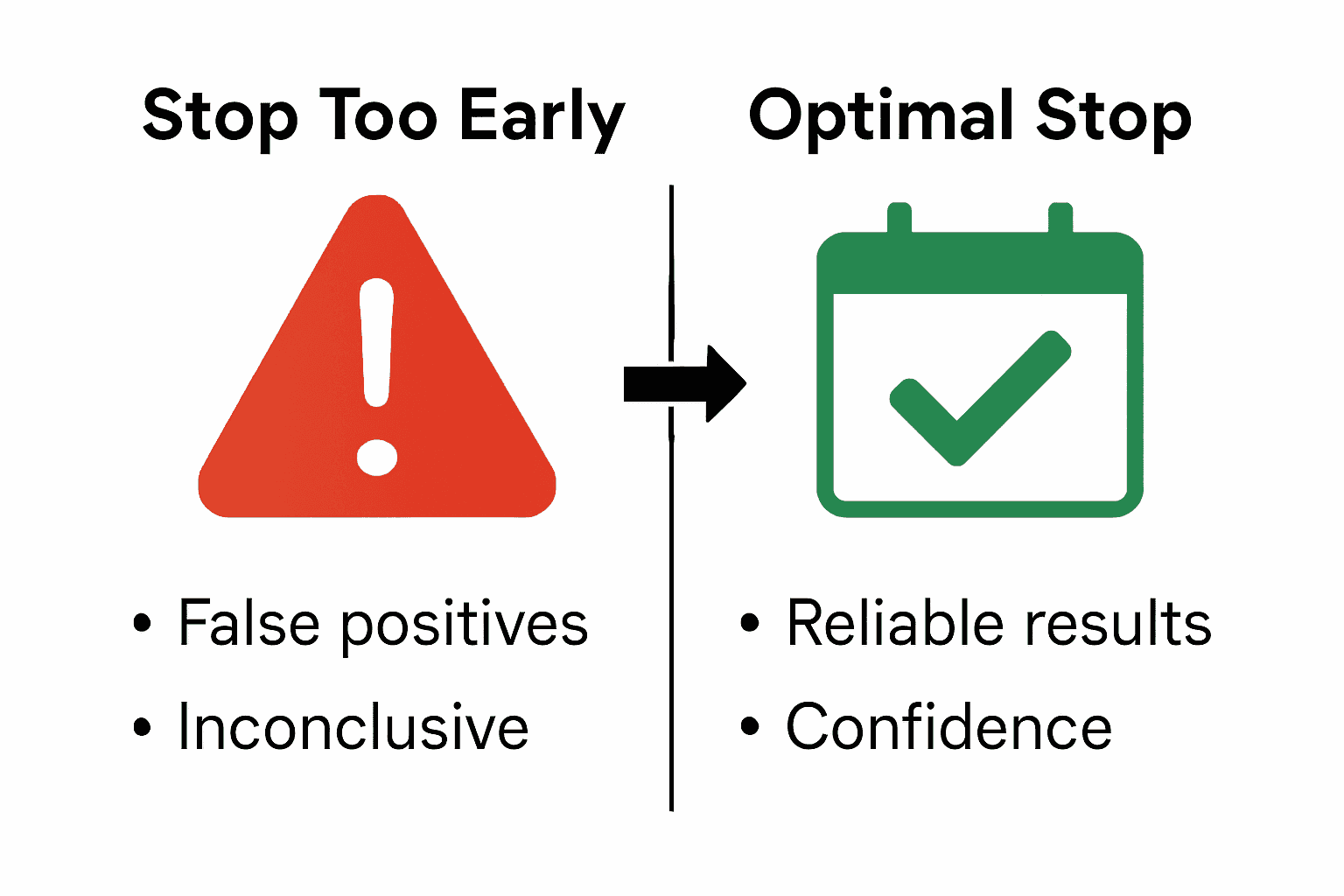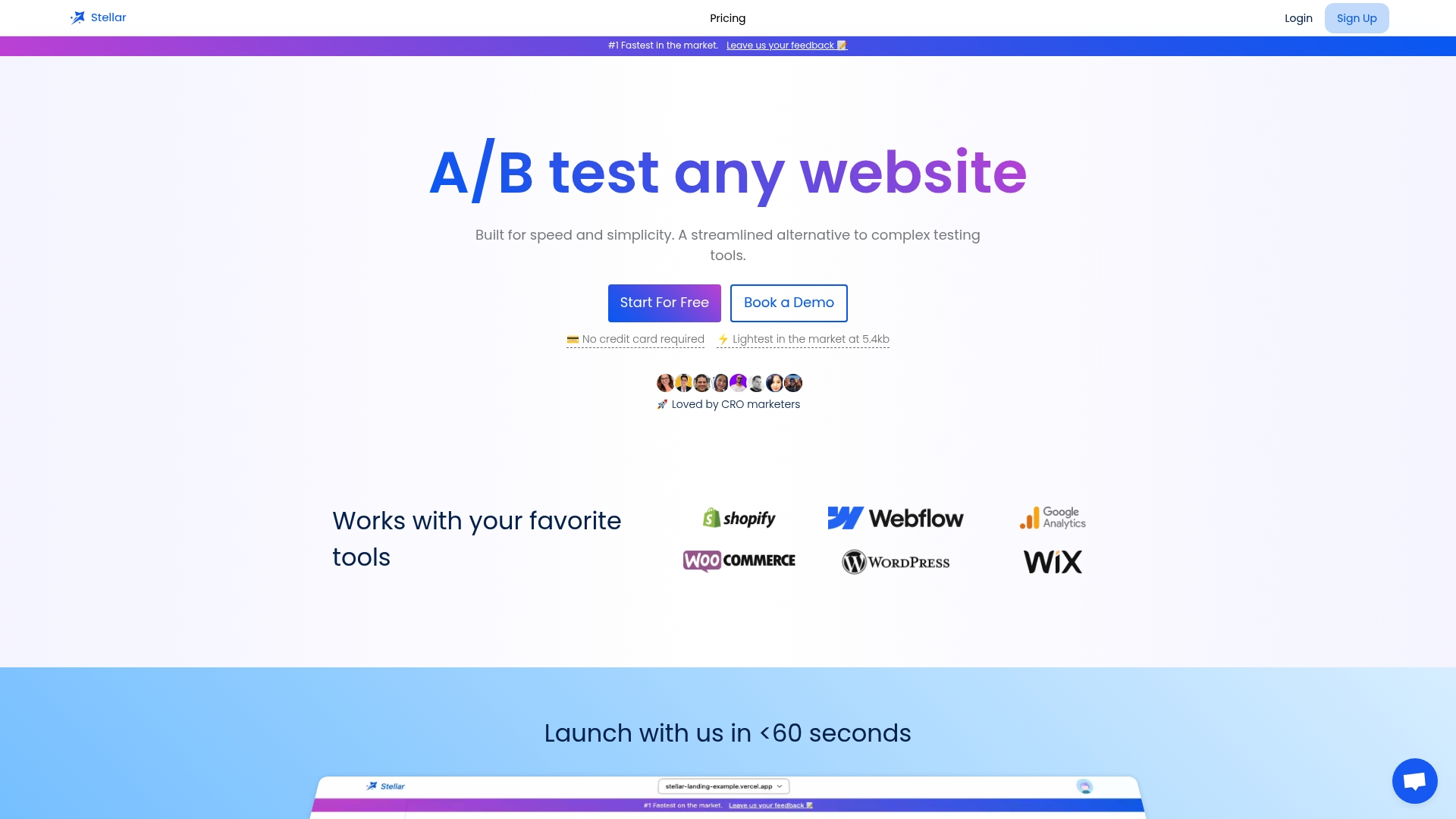
Complete Guide to When to Stop an A/B Test

Did you know that stopping an A/B test too early can double your risk of drawing the wrong conclusions? Testing isn’t just about watching numbers tick up—it’s about making smart, informed decisions that actually move the needle. Whether you’re adjusting headlines or rolling out a new product feature, knowing when to end your test can make or break your results. Discover the crucial criteria that separate guesswork from real marketing wins.
Key Takeaways
| Point | Details |
|---|---|
| Test Duration & Sample Size | Ensure tests run for a minimum of 2-4 weeks and collect sufficient samples to achieve statistical significance and meaningful results. |
| Patience in Execution | Avoid premature test termination to prevent misleading conclusions that can harm optimization efforts. |
| Alignment with Business Goals | Test duration should correspond with business cycles, accounting for seasonal variations and user buying patterns. |
| Recognizing Common Mistakes | Be aware of frequent testing pitfalls, such as insufficient sample sizes and confirmation bias, to ensure reliable experimental results. |
Table of Contents
- Defining A/B Test Stopping Criteria
- Key Statistical Concepts Explained
- Minimum Sample Size And Duration
- Impact Of Business Goals On Timing
- Risks Of Stopping Tests Too Early
- Common Mistakes And Best Practices
Defining A/B Test Stopping Criteria
Understanding when to stop an A/B test is more nuanced than simply waiting for a predetermined time or hitting a random statistical threshold. Stopping criteria are strategic decision points that help marketers make data-driven choices about their experiments.
According to Adobe Experience League, stopping an A/B test prematurely can significantly distort your confidence intervals. Key considerations for determining stopping criteria include:
Here's a comparison of typical A/B test stopping criteria and their importance:
| Criteria | Description | Why It Matters |
|---|---|---|
| Sample Size | Enough data for significance | Prevents false conclusions |
| Duration | Round to whole weeks | Reduces day-of-week bias |
| Confidence Level | Usually 95% or higher | Ensures statistical validity |
| Minimum Detectable Effect | Minimum change worth measuring | Sets meaningful thresholds |
- Sample Size: Ensure you have collected enough data to draw statistically significant conclusions
- Duration: Round test duration to whole weeks to mitigate day-of-week variations
- Confidence Level: Typically aim for 95% statistical significance
- Minimum Detectable Effect: Establish a meaningful performance difference threshold
To make a sound decision, you'll want to track multiple metrics simultaneously. Don't just focus on a single conversion point. Look at overall user behavior, engagement rates, and potential secondary impacts. Test Duration Recommendations: Optimize Your Experiments can provide further insights into creating robust testing strategies that deliver reliable results.
Remember: patience is key in A/B testing. Rushing to conclusions before your data matures can lead to misguided optimization efforts that might actually harm your conversion rates instead of improving them.
Key Statistical Concepts Explained
Statistical significance isn't just a fancy term marketers throw around—it's the backbone of making informed decisions in A/B testing. Hypothesis testing helps you determine whether the differences you observe are real or just random chance.
According to research from arXiv, Bayesian hypothesis testing offers a more nuanced approach to statistical analysis. It allows continuous monitoring of your experiments with proper stopping rules, which helps avoid the bias that can creep in when you peek at results too early. This method provides more flexible guidelines compared to traditional frequentist statistical corrections.
Key statistical concepts you'll want to understand include:
- P-Value: Measures the probability of obtaining results at least as extreme as your observed data
- Confidence Interval: A range of values likely to contain the true population parameter
- Statistical Power: The likelihood of detecting an effect when one actually exists
- Type I and Type II Errors: Potential mistakes in hypothesis testing
P-Value Explained: Understanding Statistical Significance can help you dive deeper into these critical metrics. Think of these concepts like a scientific detective toolkit—they help you separate genuine insights from statistical noise and make more reliable decisions about your A/B tests.
Minimum Sample Size and Duration
Determining the right sample size and test duration isn't a game of guesswork—it's a strategic decision that can make or break your A/B testing efforts. Sample size directly impacts the reliability and statistical significance of your experiment results.
According to research from Guided Selling, you should set a minimum test duration of 2–4 weeks and leverage power analysis tools to calculate appropriate sample sizes. Small sample sizes lead to weak statistical tests, while overly short test durations risk generating unreliable or misleading conclusions.
Key considerations for determining minimum sample size include:
- Traffic Volume: Higher website traffic allows faster test completion
- Conversion Rate: Lower conversion rates require larger sample sizes
- Minimum Detectable Effect: Smaller performance differences need larger samples
- Statistical Significance: Aim for at least 95% confidence level
Understanding Statistical Power: Essential Guide for Marketers 2025 offers deeper insights into sample size calculation. Pro tip: don't rush your tests. Patience in gathering robust data prevents costly misinterpretations and ensures your optimization efforts are truly data-driven.
Impact of Business Goals on Timing
Your business's unique rhythm can dramatically influence how long you should run an A/B test. Test duration isn't a one-size-fits-all metric—it's a strategic decision that must align with your specific business cycles and sales patterns.
According to research from Kameleoon, test duration should explicitly align with your complete business cycle length. This means running experiments for at least two full business cycles to capture comprehensive visitor behavior and account for potential seasonal or weekly variations.
Key considerations for aligning A/B test timing with business goals include:
- Sales Cycle Length: E-commerce sites might need different testing durations compared to B2B services
- Seasonal Variations: Account for holiday periods, quarterly changes, or industry-specific peaks
- Customer Purchase Frequency: Match test duration to typical customer interaction patterns
- Conversion Window: Consider how long customers typically take to make decisions
As noted by research from Julien Le Nestour, it's critical not to stop tests mid-cycle, even if you've reached minimum sample size.
Incomplete cycles can skew your results and lead to misguided optimization efforts. A B Testing Meaning: Uncover Data-Driven Insights for Better Conversions provides additional context on interpreting these nuanced testing strategies. Remember: patience in testing translates to precision in understanding your customer behavior.
Risks of Stopping Tests Too Early
Premature A/B test termination is like diagnosing an illness after checking symptoms for just five minutes—dangerous and potentially catastrophic for your marketing strategy. Early stopping can lead to statistically invalid conclusions that might tank your conversion rates instead of improving them.
According to Adobe Experience League, stopping tests when only a few observations exist dramatically increases the probability that your observed performance lift is purely coincidental. This means you could be making significant business decisions based on statistical noise rather than genuine user behavior insights.
Key risks of stopping A/B tests prematurely include:
- False Positives: High likelihood of detecting non-existent effects
- Misestimated Performance: Inaccurate long-term value projections
- Skewed Insights: Failing to capture true user behavior patterns
- Potential Revenue Loss: Implementing changes based on incomplete data
Test Duration Best Practices for Optimizing CRO Results highlights additional nuances. Research from Kameleoon warns that short test durations also fail to account for critical variability factors like holiday traffic shifts or cookie deletion rates. Patience isn't just a virtue in A/B testing—it's a mathematical necessity for obtaining reliable, actionable insights.

Common Mistakes and Best Practices
Navigating A/B testing is like walking a tightrope—one misstep can send your entire optimization strategy tumbling. Testing pitfalls are more common than most marketers realize, and understanding them is crucial to maintaining reliable experimental results.
According to research from Guided Selling, marketers frequently make critical errors such as stopping tests prematurely, ignoring proper sample size calculations, and failing to leverage advanced analytical tools like power analysis. These mistakes can transform potentially valuable experiments into misleading statistical noise.
Common A/B testing mistakes to avoid include:
- Premature Stopping: Ending tests before reaching statistical significance
- Insufficient Sample Size: Not collecting enough data for reliable conclusions
- Overlooking Variability: Failing to account for external factors
- Confirmation Bias: Interpreting results to match preconceived expectations
A/B Testing Digital Marketing: Strategies and Best Practices 2025 offers deeper insights. Research from Kameleoon recommends best practices like running tests server-side to mitigate issues with cookie deletion, calculating test duration using comprehensive business cycle analysis, and employing advanced techniques such as sequential testing and CUPED (Controlled-experiment Using Pre-Existing Data) to enhance experimental validity and efficiency. The key is patience, precision, and a commitment to methodical analysis.

Stop Guessing When to End Your A/B Tests—Take Control With Stellar
If you have ever worried about when to stop an A/B test or feared making costly decisions based on incomplete data, you are not alone. The article highlights the frustration of premature stopping, unreliable results, and the complexity of setting the right sample size and duration. You want dependable, statistically sound outcomes without the hassle and risk of technical missteps.

With Stellar, you get a fast, no-code solution that takes the confusion out of A/B testing. Our lightweight script ensures your site runs smoothly. Easy visual editing and real-time analytics mean you can track key metrics and meet your business goals with confidence. Ready to quit second-guessing and unlock trustworthy test results? Try Stellar now and see why small and medium businesses rely on us for reliable optimization. Visit Stellar’s homepage or learn more about A/B Testing Digital Marketing: Strategies and Best Practices 2025 to start making every test count.
Frequently Asked Questions
What are A/B test stopping criteria?
A/B test stopping criteria are strategic decision points that help marketers determine when to stop an A/B test based on statistical significance, sample size, duration, confidence levels, and minimum detectable effects.
Why is it important to consider sample size in A/B testing?
Sample size is crucial because it ensures that the A/B test results are statistically significant. Insufficient sample sizes can lead to false conclusions and misinterpretations of the data.
How long should an A/B test typically run?
An A/B test should generally run for 2–4 weeks, allowing enough time to capture comprehensive visitor behavior and account for seasonal or weekly variations in data.
What are the risks of stopping an A/B test too early?
Stopping an A/B test prematurely can result in false positives, misestimated performance, skewed insights, and potential revenue loss, as decisions are made based on incomplete data.
Recommended
Published: 10/15/2025